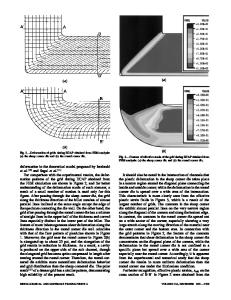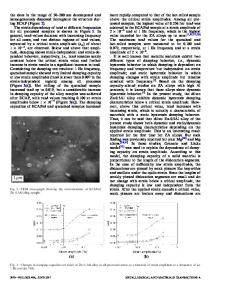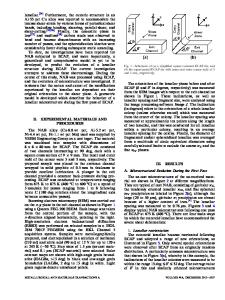Effect of rotary-die equal channel angular pressing on the thermoelectric properties of a (Bi,Sb) 2 Te 3 alloy
- PDF / 1,981,020 Bytes
- 9 Pages / 612 x 792 pts (letter) Page_size
- 89 Downloads / 415 Views
H. Hashimoto, N. Keawprak, and A.B. Ma National Institute of Advanced Industrial Science and Technology, Nagoya 463-8560, Japan
L.F. Li Technical Institute of Physics and Chemistry, Chinese Academy of Sciences, Beijing, People’s Republic of China
M.W. Barsoum Department of Materials Science and Engineering, Drexel University, Philadelphia, Pennsylvania 19104 (Received 12 March 2004; accepted 4 January 2005)
A (Bi,Sb)2Te3 alloy powder was sintered via a pulse discharge sintering process followed by a rotary-die equal channel angular pressing (ECAP) process. It was found by x-ray diffraction analysis that the as-sintered material shows preferentially orientated microstructure, which were considerably eliminated by following ECAP processes. Generally, the Seebeck coefficient of the material was reduced by ECAP processing, which was attributed to the increased carrier concentration after the severe plastic deformation. Electrical conductivity increases after ECAP, which was also originated from the increased carrier concentration. The figure of merit of the material in different conditions shows higher value in the transverse direction. In the transverse samples, those after ECAP processing showed increased figures of merit, which reached 3.85 × 10−3/K in the material after 4 passes of ECAP.
I. INTRODUCTION
Bi2Te3-type1 alloy for thermal electrical energy conversion, particularly for near-room-temperature cooling, has received great attention in recent decades.1–7 The higher figure of merit near room temperature compared with other materials made this material a good candidate for materials in the limited market of consumers cooling products. However, the performance of this material is still far from satisfactory for wider application since the energy-conversion efficiency is still low. Much effort has been devoted to the development of materials with improved thermoelectric (TE) performance by designing alloying and processing.3,4,8 Dissolving Sb2Te3 in Bi2Te3 is an efficient way to improve the properties. These two alloys have identical crystal structures and are completely soluble in each other. The solid solutions increase phonon scattering but do not affect the scattering to electronic carries.1 In other words, the thermal conductivity of the material is reduced, while a)
Address all correspondence to this author. e-mail: [email protected] DOI: 10.1557/JMR.2005.0120 J. Mater. Res., Vol. 20, No. 4, Apr 2005
http://journals.cambridge.org
Downloaded: 15 Mar 2015
not greatly affecting the electrical conductivity , which leads to the increase in the figure of merit of the material as defined as Z = S2 Ⲑ
(1)
,
where S is the Seebeck coefficient. The figure of merit Z of (Bi,Sb)2Te3 is in the vicinity of 3 × 10−3/K,9–13 with the ZT value of about 1.0 at room temperature. However, to achieve an energy-conversion efficiency equivalent to current compressors in commercial refrigerators, a ZT of about 4.0 is required. Hence the need to try to further improve the figure of merit (FM) of (Bi,Sb)2Te3 has nev
Data Loading...











